Key takeaways:
- Woolf’s use of stream-of-consciousness narrative immerses readers in her characters’ thoughts, blending internal and external realities.
- Key themes in her work include the exploration of gender, identity, and temporal dislocation, evoking deep reflection on human experience.
- Woolf’s vivid imagery and symbolism enrich her prose, allowing readers to appreciate the beauty in everyday moments and the complexities of life.
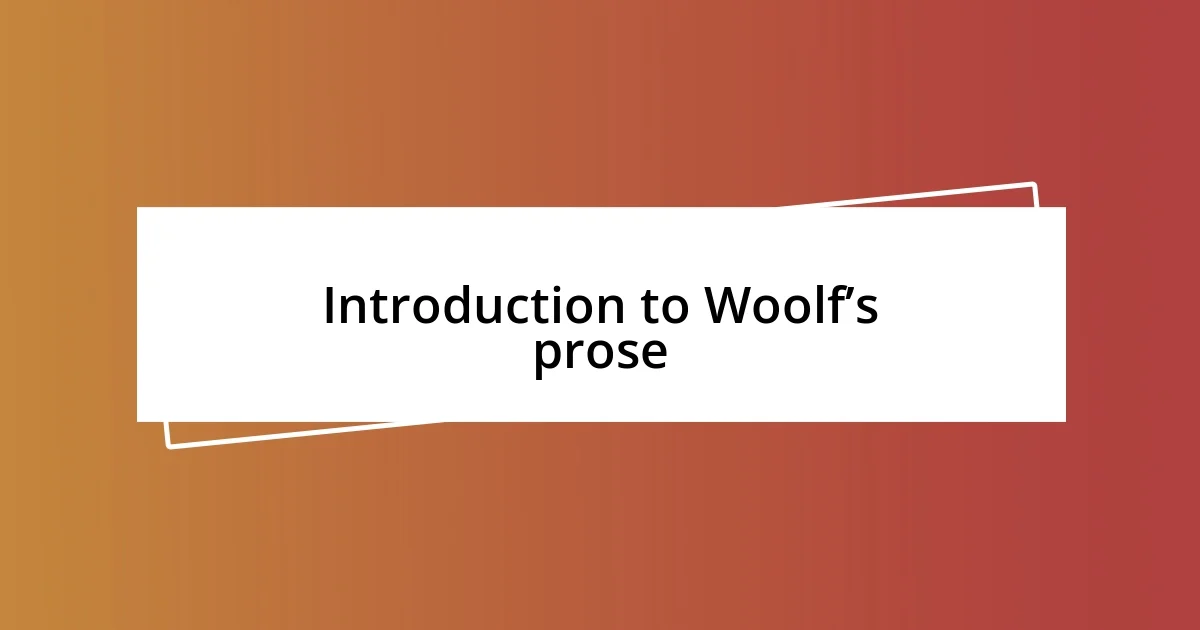
Introduction to Woolf’s prose
Virginia Woolf’s prose is nothing short of a journey into the depths of human consciousness. I remember the first time I picked up “Mrs. Dalloway.” It felt as if I were walking alongside Clarissa, experiencing her thoughts in real time. This stream-of-consciousness technique is a hallmark of Woolf’s style, placing the reader directly into the minds of her characters, allowing us to feel their complexities in a visceral way.
What strikes me most about Woolf’s writing is her lyrical quality. Her use of imagery and rhythm transforms everyday moments into profound reflections on life. For instance, when she writes about time’s passage, it resonates with me on a personal level. Have you ever paused to reflect on a fleeting moment that changed everything? Woolf captures that essence, making the ordinary seem extraordinary.
In her narratives, I often find a delicate balance between detailed observation and broader philosophical themes. Woolf’s attention to the minute details of a character’s inner life reveals universal truths about identity, gender, and mental health. It’s like she invites us to examine our own lives, encouraging introspection and connection. Isn’t it fascinating how words can evoke such powerful emotions and thoughts?
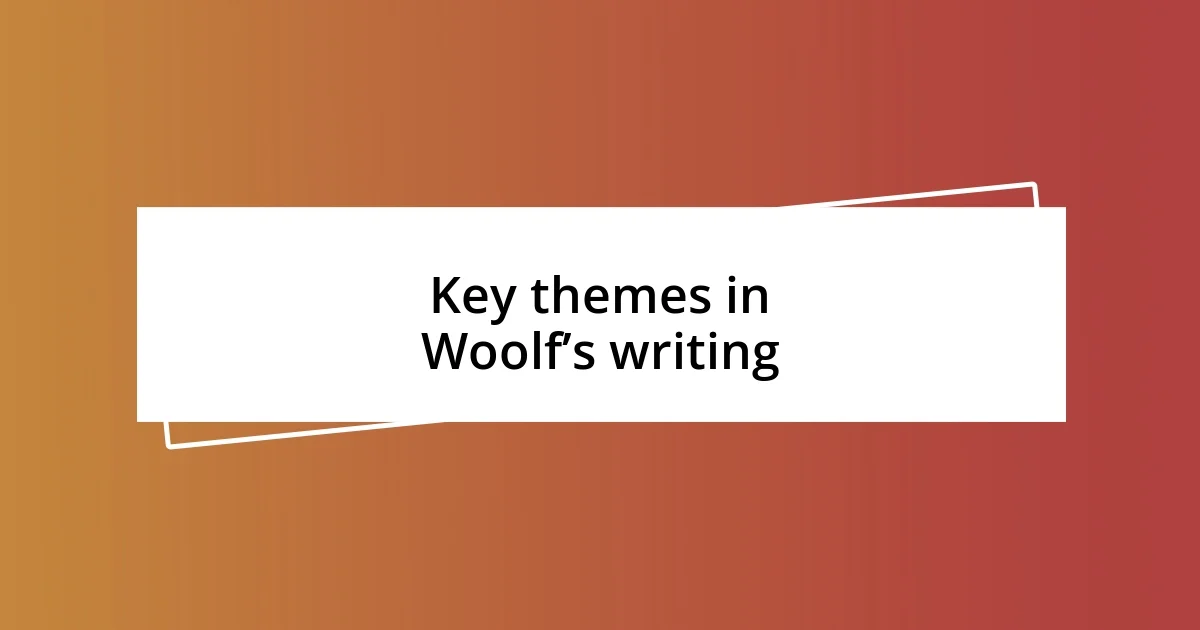
Key themes in Woolf’s writing
Woolf’s writing resonates deeply with themes of time and memory, which I find quite profound. I vividly recall reading “To the Lighthouse” and feeling the inexorable passage of time through the characters’ lives. Each scene unfolds like a delicate photograph, capturing fleeting moments that seem to linger long after the page is turned. There’s a profound awareness that life is a tapestry woven with both mundane and extraordinary experiences.
Key themes in Woolf’s writing include:
- Stream of Consciousness: Her narrative style immerses readers in a character’s thoughts, blurring the lines between internal and external realities.
- Gender and Identity: Woolf intricately explores the roles and expectations of women, pushing boundaries and challenging societal norms, particularly in “A Room of One’s Own.”
- Temporal Dislocation: She frequently juxtaposes past and present, illustrating how memories shape our perception of the present moment.
- Isolation and Connection: Many of her characters grapple with feelings of isolation, reflecting a desire for connection that is both universal and deeply personal.
- The Nature of Reality: Woolf invites readers to question the nature of reality itself, considering how subjective experience colors our understanding of the world around us.
In reflecting on these themes, I often find myself drawn back to her work during times of uncertainty. Woolf’s insight into the human condition reminds me that even the simplest thoughts can carry the weight of our experiences. Her ability to distill complex emotions into relatable narratives makes her prose not just literature, but a mirror to our own lives.

Character development in her works
Woolf’s character development is particularly striking because she doesn’t just create characters; she crafts intricate portraits of human experience. For example, in “Mrs. Dalloway,” I was captivated by the way she weaves the lives of Clarissa Dalloway and Septimus Warren Smith. Their journeys, though seemingly disparate, converge upon the themes of mental health and societal expectation. This duality resonates with me deeply; it showcases how individuals can feel both isolated and profoundly connected through shared human experiences.
In “To the Lighthouse,” I often reflect on the character of Lily Briscoe. Woolf’s portrayal of her struggle as an artist and a woman is painfully relatable. I recall my own experiences of self-doubt when pursuing creative endeavors. Woolf pushes us to see the evolution of Lily not just as a character within the story, but as a voice for all women striving to assert themselves in male-dominated spheres. It’s a beautiful reminder that every character’s arc is a reflection of broader societal issues.
What truly sets Woolf apart is her ability to portray internal conflict with such finesse. Take the character of Jacob Flanders in “Jacob’s Room.” His journey evokes a sense of nostalgia that I often grapple with when looking back at my own formative years. Woolf captures the complexity of growth, loss, and identity so poignantly that it feels as if I’m threading my own memories through her narrative. Each character not only tells their story but invites me to introspect on my own life’s intricacies.
| Character | Development |
|---|---|
| Clarissa Dalloway | Her internal struggles highlight societal pressures, creating a dialogue about mental health. |
| Lily Briscoe | Her journey reflects the challenges faced by women in art, serving as a beacon for self-assertion. |
| Jacob Flanders | His arc beautifully encapsulates the nostalgia and complexity of youthful growth and identity. |
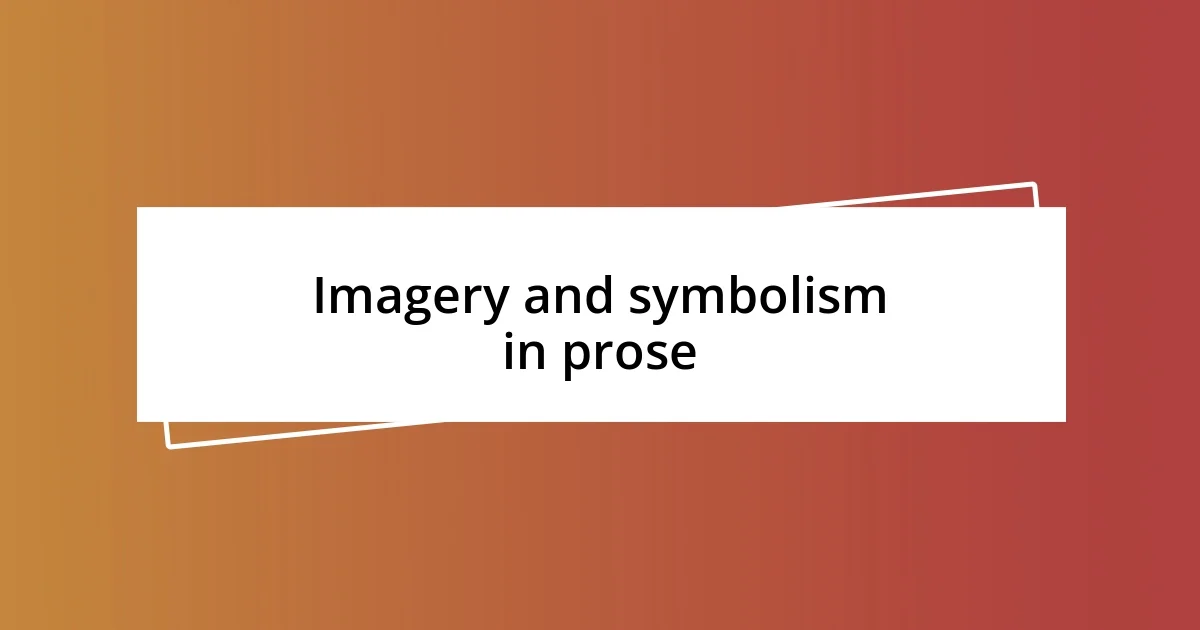
Imagery and symbolism in prose
Woolf’s prose is painted with a vivid brush of imagery that brings her characters and settings to life. I often find myself immersed in details like the “tides of the sea” or the “fluttering curtains” that convey not just a scene but an emotional atmosphere. It’s as if she composes a symphony of sights and sounds, inviting me to feel the essence of a moment. Have you ever felt so transported by a description that you almost forgot you were reading? That’s precisely what happens in her work, where every image contributes to a larger emotional tapestry.
The symbolism woven into her narratives also communicates profound insights about the human experience. In “To the Lighthouse,” the lighthouse itself serves as a powerful symbol of aspiration and the passage of time. I remember pondering how it represents both a beacon of hope and the elusive nature of our goals. This duality resonates with me, reminding me of moments in my life when my dreams felt both tangible and distant. Woolf’s use of symbols challenges me to reflect on my own aspirations and their meanings throughout my journey.
When I think about her ability to intertwine imagery and symbolism, I’m reminded of the impact such techniques have on my understanding of the story. For instance, the moment in “Mrs. Dalloway” where the flowers Clarissa arranges transform from mundane to extraordinary through her introspection speaks volumes. Isn’t it fascinating how a simple action can blossom into a meditation on life? Woolf makes me appreciate the beauty in the everyday, prompting me to seek deeper meanings in my own experiences.
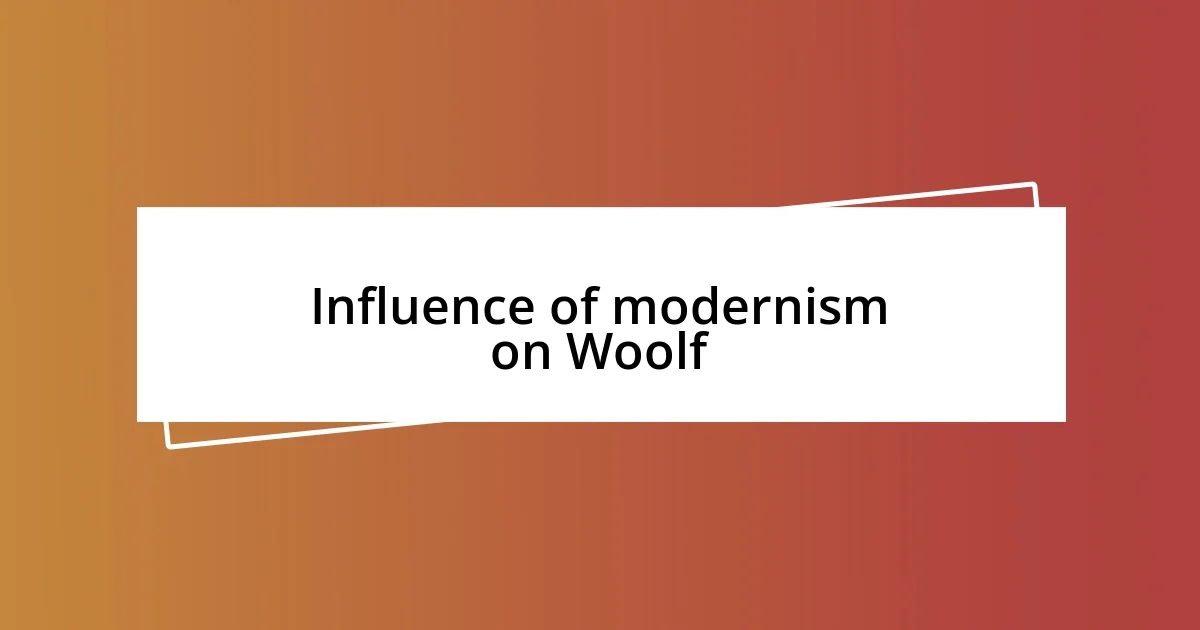
Influence of modernism on Woolf
Woolf’s prose embodies the essence of modernism, capturing the nuances of consciousness in a fragmented world. I’ve often marveled at how she uses stream-of-consciousness as a narrative technique, allowing readers to dive deep into her characters’ thoughts and feelings. It’s a little like listening to a friend’s inner monologue—intimate yet revealing of broader truths about society.
What strikes me is her focus on temporality and perception. In “Mrs. Dalloway,” time doesn’t flow linearly; it ebbs and flows as the characters drift between memories and the present. Reflecting on my own life, I often find myself caught in a similar dance of past and present, which makes her exploration of time deeply relatable. Have you ever felt like a moment seemed to stretch infinitely, only to be abruptly interrupted by reality? That’s the beauty of Woolf’s modernist lens; she encapsulates that very tension beautifully.
Moreover, Woolf’s departure from traditional storytelling aligns perfectly with modernist ideals. I recall how her refusal to conform to rigid structures resonated with my own creative struggle. When I write, I sometimes yearn for that freedom to break barriers and explore unconventional forms. This fluidity in her writing inspires me to embrace ambiguity and complexity, reminding me that life itself is not always neatly packaged but rich with experience.
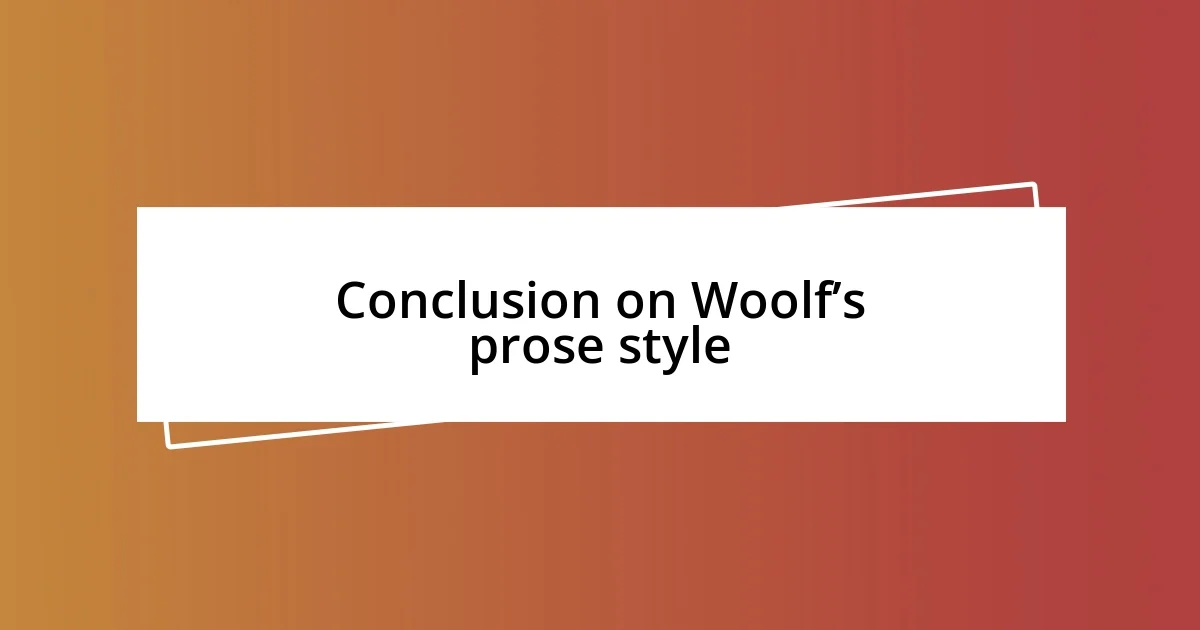
Conclusion on Woolf’s prose style
Woolf’s prose style encapsulates an emotional depth that draws readers into the characters’ inner worlds. I remember my first encounter with “To the Lighthouse”; the way she unravels the characters’ thoughts amidst the backdrop of everyday life left me in awe. It feels as though she takes my hand and guides me through their emotional landscapes, allowing me to experience their joys and sorrows as if they were my own.
Beyond the emotional nuances, her innovative structure plays a crucial role in how I perceive her narratives. I often find myself reflecting on how Woolf blurs the boundaries between time, thought, and action. It’s intriguing to think about how this non-linear approach mirrors the complexities of life itself. Have you ever noticed how memories can intertwine unexpectedly with the present? Woolf captures that beautifully, making her work resonate profoundly with my own experiences—sometimes fragmented, often chaotic, but always meaningful.
Ultimately, what I admire most is her fearless exploration of the human psyche. Woolf’s prose inspires me to embrace my own vulnerabilities and uncertainties. I think about how, through her writing, she invites me to question the very nature of reality and perception. Isn’t it refreshing to encounter a writer who challenges us to look beyond the surface? This unique approach not only illuminates my understanding of literature but also deepens my appreciation for the intricate tapestry of life itself.














